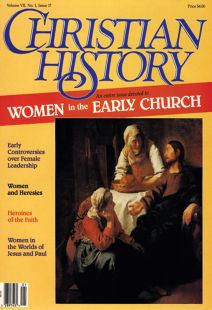From the Archives: Egeria at Thecla’s Shrine
CONSTANTINE'S MOTHER, Helena, traveled to Palestine, touring biblical sites and, with her imperial wealth, establishing churches and shrines. Thereafter, it was quite fashionable for Christians to visit the Holy Land. Late in the 4th century, a nun named Egeria made the trek from western Europe and kept a diary of her travels. Not far from Tarsus, she visited the shrine of Thecla, then considered a historical figure.
Since the martyrium of St. Thecla is three days from Tarsus, that is, in Isauria, it pleased me much to go on there, especially since it was so close by . . . . When I arrived there, I went to the bishop, a truly holy man and a former monk. I also saw there a very beautiful church in the same city.
Since St. Thecla’s shrine is placed above the city on a flat hill, perhaps 1500 feet from the city, I chose to go out there to make the lodging that had to be made. At the holy church there is nothing else except innumerable monastic cells for men and women.
For I found there one of my dearest friends, a person in whose way of life everybody in the east bears witness, the holy deaconess named Marthana, whom I had met in Jerusalem where she had come up to pray. She governs there monastic cells of “apotactites” or virgins. Would I be able to describe her joy or mine when she saw me?
But I should return to my subject. There are a great many monastic cells there on that hill and in the middle is an immense wall that encloses the church in which is the martyrium, for the martyrium is very beautiful. Therefore the wall was put there to guard the church against the Isaurians who are evil and often steal, lest they try to do something against the monastery placed there.
When I had arrived there in the name of God, a prayer was given at the martyrium and the entire Acts of St. Thecla were read. I gave boundless thanks to Christ our God who counted me worthy, though I was unworthy and undeserving, to fulfill my desires in all things.
I stayed there for two days, seeing the holy monastics or “apotactites,” men as well as women, who were there, and after praying and receiving communion, I returned to Tarsus to continue on my route . . . .
By Egeria
[Christian History originally published this article in Christian History Issue #17 in 1988]
Next articles
Women and the Early Church: Recommended Resources
Historical writings and pespectives, Scripture studies, bibliographies about early church women.
the EditorsHistory of Russian Christianity: From the Publisher
Introduction to the Millennium of Russian Christianity.
the EditorsHistory of Russian Christianity: Did You Know?
Fascinating facts about Russian Christianity.
the EditorsThe Orthodox Art/Ministry of Icons
Icons are produced according to strict, widely held standards, by artists who must train for years.
the EditorsSupport us
Christian History Institute (CHI) is a non-profit Pennsylvania corporation founded in 1982. Your donations support the continuation of this ministry
Donate



